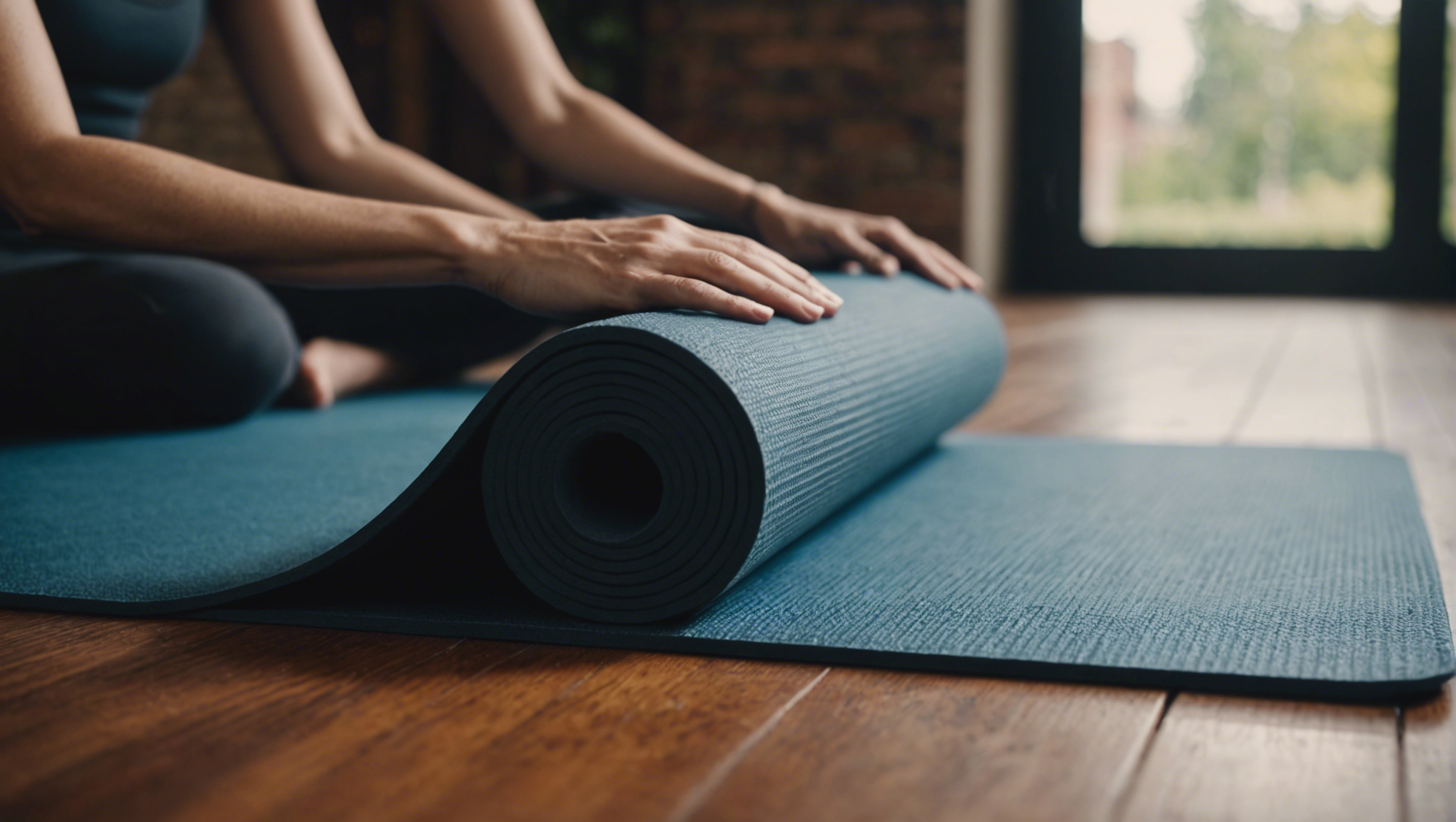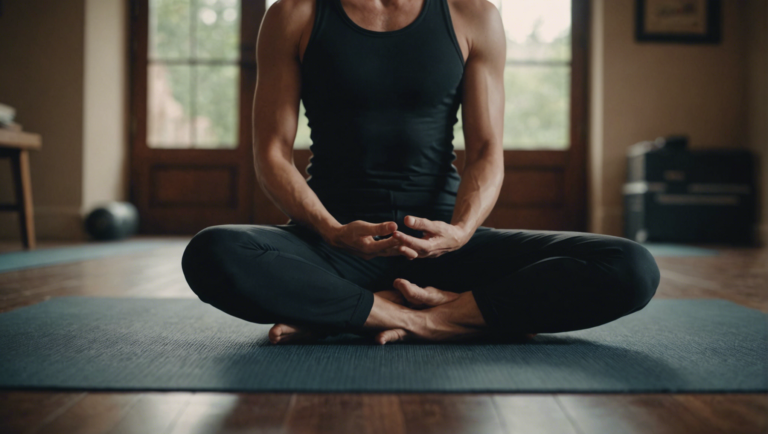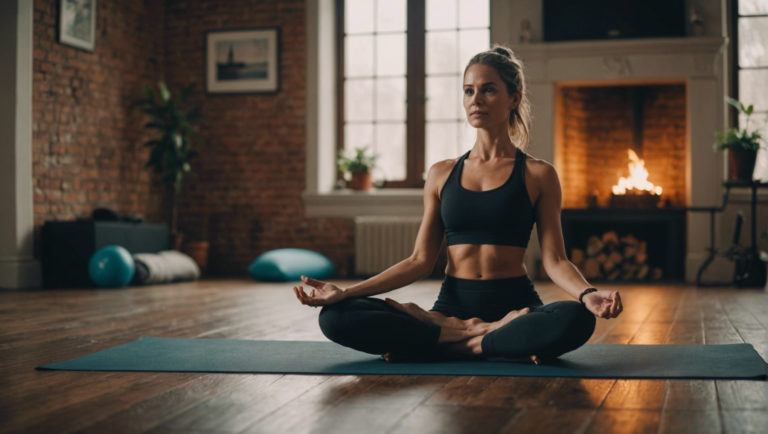Discovering The Best Yoga Mat: A Comprehensive Guide
The Quest for the Perfect Yoga Mat: What Matters Most?
Embarking on a yoga journey introduces a pivotal decision early on: selecting the right yoga mat. This choice, seemingly simple, carries significant weight in the practice of yoga. What makes for an ideal yoga mat? The answer is multifaceted, requiring a deeper look into factors such as material, thickness, texture, and environmental impact.
Understanding the Importance of Material
Yoga mats are fashioned from a variety of materials, each offering unique benefits. Traditional options include PVC, known for its durability and grip, but raised concerns regarding environmental sustainability prompt many to seek alternatives. Eco-friendly materials like natural rubber, jute, and cork have surged in popularity, offering a sustainable option without compromising performance. Choosing the right material affects not only one’s practice but also aligns with personal values concerning health and the environment.
Deciphering the Role of Thickness and Texture
The thickness of a yoga mat can greatly influence comfort, especially during kneeling or lying positions. A standard yoga mat typically measures around 1/8 inch thick, providing a solid connection to the floor for stability. Those seeking extra cushioning for joint support might gravitate towards thicker options. However, thicker mats can make balancing poses more challenging and portability may be compromised.
Texture dictates traction, influencing how effectively a mat supports poses without slipping. Mats with a pronounced texture offer increased grip, beneficial for practices involving vigorous movements or where moisture is a factor. On the flip side, some individuals might prefer a smoother surface for comfort during extended periods of floor contact.
Evaluating Durability and Ease of Cleaning
A yoga mat’s longevity is anchored in its material composition and thickness. Mats subject to daily rigorous practice or outdoor sessions require resilient materials to withstand wear and tear. Considering the cleaning and maintenance aspect is crucial; a mat that is easy to clean and dries quickly is essential for hygiene, especially for those practicing hot yoga or using their mat frequently.
Reflecting on Environmental Impact and Sustainability
Sustainability has become a cornerstone in choosing a yoga mat. Non-toxic, biodegradable materials echo the ethical principles of yoga by reducing environmental impact. Brands are increasingly acknowledging this shift, offering mats made from renewable resources, devoid of harmful chemicals, and implemented through fair labor practices. Opting for eco-conscious mats contributes to a holistic approach to yoga that embodies respect for all living beings and the planet.
Aligning with Personal Needs and Practice Style
The diversity in yoga practices—from restorative to power yoga—demands consideration when selecting a mat. A mat that serves well in dynamic sequences may not provide the comfort needed for slower, more meditative practices. Furthermore, personal preferences in color, design, and texture play a role in how one connects with their mat, potentially enhancing the overall yoga experience.
The Intersection of Price and Quality
Investing in a high-quality yoga mat is investing in one’s practice. While higher-priced options often guarantee durability and superior materials, there are budget-friendly choices that do not compromise significantly on quality. Striking a balance between cost and desired features is key, recognizing that a good yoga mat can elevate practice, providing comfort, stability, and alignment support.
In the pursuit of the perfect yoga mat, a thorough examination of one’s practice, values, and needs is indispensable. The convergence of material, comfort, sustainability, and personal preference frames a decision that is deeply personal yet universal in its significance. This quest is not merely about acquiring a piece of equipment but about making a choice that enhances the physical, environmental, and spiritual dimensions of yoga. By prioritizing these considerations, pracitioner can select a mat that not only supports their poses but also their journey towards wellness and mindfulness.
Material Matters: Decoding What Your Yoga Mat is Made Of
Yoga, a practice that embodies the unity of mind, body, and spirit, has transcended its ancient origins to become a staple of modern wellness culture. Central to this practice is a tool as humble as it is essential: the yoga mat. However, not all mats are created equal. The material composition of your yoga mat not only influences your practice’s comfort and efficacy but also its environmental impact. Delving into the materials that constitute your yoga mat can illuminate the intersection of sustainability, health, and performance in your yoga journey.
Understanding the Spectrum of Yoga Mat Materials
From natural resources to advanced synthetics, the array of materials used in yoga mats offers a diverse palette for yogis to choose from, each catering to different preferences and values.
Natural Rubber: The Eco-Conscious Choice
Natural rubber, derived from the sap of rubber trees, presents an eco-friendly option for those who prioritize environmental sustainability. Its inherent grip and cushioning properties make it an excellent material for yoga mats, providing a stable and supportive surface for a variety of practices. However, individuals with latex allergies should consider alternative materials.
TPE (Thermoplastic Elastomer): Striking a Balance
Thermoplastic elastomer, a blend of plastic and rubber, stands out for its versatility and moderate environmental footprint. TPE yoga mats are lauded for their lightweight nature, non-toxicity, and recyclability, bridging the gap between performance and eco-consciousness. They offer an appealing middle ground for yogis seeking to balance sustainability with functionality.
PVC (Polyvinyl Chloride): The Durability Champion
PVC has historically dominated the yoga mat market due to its unparalleled durability and affordability. Its water-resistant properties and ease of cleaning appeal to many practitioners. However, PVC’s environmental and health implications have spurred a shift towards more sustainable alternatives. The material’s non-biodegradability and potential to release harmful chemicals during production and disposal raise concerns for eco-minded yogis.
Jute and Cotton: Embracing Tradition with a Modern Twist
In a nod to yoga’s ancient roots, some modern mats incorporate natural fibers like jute and cotton. These materials offer a textured grip and enhance the mat’s breathability, suited particularly for practices involving high levels of moisture. With their biodegradability and renewable nature, jute and cotton mats embody a harmonious marriage of tradition and environmental consciousness.
Navigating the Trade-Offs: Performance vs. Sustainability
The choice of material has profound implications for both the practitioner and the planet. Natural and biodegradable materials like jute, cotton, and natural rubber align with the yogic principle of Ahimsa, or non-harm, by minimizing environmental impact. Yet, their longevity and performance may not match those of their synthetic counterparts. On the other hand, materials like PVC and TPE offer durability and superior performance characteristics but at an environmental cost. Thus, selecting a yoga mat material involves weighing personal values, practice needs, and ecological considerations.
The Future of Yoga Mats: Innovation and Sustainability
The evolving landscape of yoga mat manufacturing reflects a growing commitment to sustainability and health-consciousness within the yoga community. Advances in material science promise the development of new, eco-friendly materials that do not compromise on performance or durability. Innovations such as recycled and plant-based materials pave the way for a new generation of yoga mats that support both the individual’s practice and the collective well-being of the planet.
In essence, the material of your yoga mat serves as a silent guide in your yoga journey, influencing your practice in subtle yet significant ways. By making informed choices about the materials beneath our palms and feet, we contribute to a practice that honors not only our individual health and performance but also the health of our environment. As the fabric of yoga continues to weave itself into the tapestry of modern life, let us choose materials that reflect our values, aspirations, and respect for the earth.
Grip and Slip: How Texture Affects Your Yoga Practice
The Critical Role of Mat Texture in Yoga
Yoga is not just a practice but a journey towards inner peace and physical health. The tools we use on this journey, especially our yoga mats, play a crucial role in enhancing or detracting from our experience. The texture of a yoga mat significantly impacts one’s practice, affecting grip, comfort, and overall performance. Understanding the interplay between grip and slip on various mat textures can guide yogis in making informed choices that support their practice style and preferences.
Exploring Different Types of Yoga Mat Textures
Yoga mats come in a myriad of textures, each offering a unique feel and performance characteristic. From the smooth and slick to the rough and grippy, understanding these differences is crucial for practitioners who seek to optimize their practice.
- PVC Mats: These mats often have a smoother surface and can provide a moderate grip, though they may become slippery when wet. Ideal for those who prefer a softer surface without too much stickiness.
- Rubber Mats: Known for their eco-friendly material, rubber mats boast a more textured surface. This provides excellent grip, even in the face of sweat, making them a favorite among hot yoga enthusiasts.
- Cork Mats: A rising star in the yoga community, cork mats offer a unique combination of natural grip and antimicrobial properties. The grip on cork mats improves with moisture, making them a solid choice for vigorous practices.
- Jute Mats: Another eco-friendly option, jute mats feature a rough texture that provides natural grip. However, the surface may feel uncomfortable for some, especially in poses that require prolonged contact with the mat.
How Texture Influences Your Practice
The texture of your yoga mat does more than just influence your physical grip; it affects your mental concentration, comfort, and ability to maintain poses. A mat that’s too slippery can be a constant distraction, pulling your focus away from your practice and towards preventing falls. Conversely, a mat with too much grip can hinder the flow of dynamic practices, such as Vinyasa, where smooth transitions between poses are key.
Finding Your Ideal Mat Texture
Selecting the right yoga mat texture is a highly personal decision, influenced by your practice style, sensitivity levels, and even where you practice.
- For Dynamic or Hot Yoga: Look for mats with a high grip level, such as rubber or cork, to prevent slipping in sweaty conditions.
- For Gentle Yoga: A smoother PVC or soft rubber mat may provide the comfort and slight grip needed without the stickiness that can impede movement.
- Sensitivity Concerns: If you have sensitive skin or joints, consider the softness of the mat. A too rough texture might be uncomfortable, whereas a smoother mat could provide the cushioning and comfort needed.
Maintaining Your Mat’s Optimal Texture
Proper care extends the life of your yoga mat and maintains its texture. Regular cleaning, according to the manufacturer’s instructions, helps prevent the build-up of oils and sweat that can affect grip. Air drying away from direct sunlight and avoiding harsh cleaning chemicals will preserve the mat’s integrity and grip quality.
Uniting Grip and Slip for Advanced Practices
Advanced yogis know the importance of balancing grip and slip in their yoga mat. They might use different mats for different practices or even use towels to adjust the level of grip on the fly. Listening to your body and observing how different textures affect your practice is key to finding your balance between grip and slip.
Through this exploration of how texture influences yoga practice, it becomes evident that the choice of a yoga mat goes beyond color and price. It’s an essential tool that supports your journey towards achieving higher yoga goals. Whether you’re a beginner or an advanced practitioner, taking the time to understand and choose the right texture can enhance your practice, making every session more enjoyable and effective.
The Thickness Dilemma: Balancing Comfort and Stability
When embarking on a journey through the world of yoga, practitioners soon encounter a variety of choices—none more persistent than the selection of a suitable yoga mat. Among the myriad of features to consider, the thickness of a yoga mat emerges as a pivotal factor that influences both comfort and stability during practice. This balancing act between cushioning for the joints and a firm grounding for balance poses presents a dilemma for yogis at all levels. Understanding the nuanced interplay between these aspects is essential for making an informed decision tailored to individual needs and practice styles.
Unpacking the Impact of Thickness on Comfort
The thickness of a yoga mat directly correlates with the level of comfort it provides, especially on hard surfaces. Mats ranging in thickness from about ⅛ inch (approximately 3mm) to ¼ inch (around 6mm) are common in the market. Thicker mats, often upwards of ¼ inch, offer enhanced cushioning, which can be a boon for practitioners with sensitive joints or those engaging in restorative or Yin yoga sessions where poses are held for longer durations. The added padding can alleviate pressure on the knees, hips, and spine, making a significant difference in comfort levels during floor-based asanas.
However, a thicker mat can sometimes dampen the practitioner’s connection to the floor, which is a key aspect of stability in yoga. The quest for comfort, therefore, should not wholly overshadow the requisite stability needed for a safe and effective practice.
Stability and the Thinner Mat Advantage
In the realm of yoga, where balance and precision play critical roles, the stability offered by a yoga mat is indispensable. Thinner mats, typically around ⅛ inch, provide a firm surface that facilitates a strong connection to the ground. This grounding is crucial for standing poses, balancing asanas, and dynamic flows that demand stability and proprioceptive awareness.
A thinner mat ensures that yogis can feel the floor beneath them, allowing for minor adjustments in foot positioning that enhance balance and alignment. For practices that include advanced postures, inversions, or more vigorous sequences, the stability provided by a thinner mat can contribute significantly to the safety and efficacy of the practice.
Striking the Perfect Balance
The process of selecting the ideal mat thickness is not a one-size-fits-all proposition. It demands a thoughtful consideration of individual preferences, type of yoga practice, and personal comfort and stability requirements.
For those prioritizing mobility or practicing more dynamic styles of yoga, such as Vinyasa or Ashtanga, a thinner mat may offer the best blend of stability and portability. Conversely, yogis focusing on slower, more meditative practices, or those with physical sensitivities, might find a slightly thicker mat more conducive to their needs.
Some practitioners opt for a middle-ground approach, choosing mats that offer a moderate thickness—around 5mm—as a compromise, attempting to harness both comfort and stability. This thickness often provides a balance between cushioning and connection, suitable for a broad range of practices.
Personal Trials and Expert Consultation
Ultimately, the journey to finding the optimal yoga mat thickness is a personal one, enhanced by trial and experience. Testing various mats through practice, or consulting with experienced yoga instructors, can offer invaluable insights into how different thicknesses impact one’s comfort and stability during different styles of yoga.
In addition to thickness, other factors including material, texture, and eco-friendliness can also influence the overall choice of a yoga mat. As such, while the thickness is a vital consideration, it should be one of many in the pursuit of a mat that supports a holistic and satisfying yoga practice.
Through careful consideration and personal experimentation, yogis can navigate the thickness dilemma to discover a yoga mat that aligns with their individual needs, enhancing both the comfort and stability of their practice. Whether for a beginner or an experienced practitioner, the right choice of mat can significantly influence the journey through the transformative path of yoga.
Sustainability in Your Yoga Practice: Eco-Friendly Yoga Mats Explored
As the world shifts towards more sustainable practices, yoga enthusiasts are increasingly looking for ways to align their practice with their environmental values. This has brought eco-friendly yoga mats into the spotlight, offering a way to blend mindfulness with eco-consciousness. Understanding the importance of sustainability in yoga practice requires diving into the materials, production processes, and lifecycle of eco-friendly yoga mats, exploring how these aspects contribute to a more sustainable world.
Why Eco-Friendly Yoga Mats Matter
Eco-friendly yoga mats represent more than just an accessory for your practice; they are a statement of your commitment to protecting the environment. Traditional yoga mats are often made from PVC (polyvinyl chloride), a plastic that releases harmful chemicals during production and does not biodegrade, contributing to landfill waste. In contrast, eco-friendly mats use natural and recycled materials that are kinder to the planet. These materials, such as natural rubber, jute, and organic cotton, provide sustainable alternatives without sacrificing quality or functionality.
Exploring Sustainable Materials and Production
The cornerstone of eco-friendly yoga mats is the use of sustainable materials. Natural rubber, sourced from rubber trees, offers excellent grip and durability, making it a popular choice. Jute, a highly renewable plant, adds a unique texture and fibrous strength to mats, while organic cotton is prized for its softness and washability. These materials not only minimize environmental impact but also enhance the user’s yoga experience with their natural feel.
The production process of eco-friendly yoga mats also focuses on reducing carbon footprint and ensuring ethical labor practices. Manufacturers often utilize green energy sources, such as solar or wind power, and adhere to strict standards that promote fair wages and safe working conditions. This commitment extends beyond the mat, with many companies participating in programs to offset their carbon emissions and support environmental initiatives.
Lifecycle and End-of-Life Considerations
An integral aspect of eco-friendly yoga mats is their consideration for the lifecycle and end-of-life of the product. Durability is a key focus, with these mats designed to last longer, reducing the need for frequent replacements. Additionally, many eco-friendly mats are recyclable or biodegradable, ensuring that once they have reached the end of their usable life, they can be disposed of in a way that minimizes environmental impact.
Navigating the Market: Tips for Choosing an Eco-Friendly Mat
With the growing popularity of eco-friendly yoga mats, it’s essential to know how to choose the right one. First, look for mats made from sustainable materials, such as natural rubber or jute, and check for certifications that validate their eco-friendly claims, such as the OEKO-TEX or EcoCert certification. Consider the mat’s thickness and grip to ensure it meets your personal practice needs while still prioritizing environmental considerations.
The Ripple Effect of Your Choice
Choosing an eco-friendly yoga mat has a ripple effect that extends beyond the individual. It supports a larger movement towards sustainable living and environmental stewardship, inspiring others in the yoga community to make more conscious choices. Moreover, it encourages manufacturers to innovate and expand their sustainable offerings, pushing the market towards greener solutions.
By selecting an eco-friendly yoga mat, you contribute to a more sustainable world, marrying the principles of yoga—unity, mindfulness, and respect—with tangible actions that honor the earth. Your practice becomes a reflection of your values, demonstrating that every choice, no matter how small, plays a part in shaping a healthier planet for future generations.
Engaging in yoga with an eco-friendly mat is a powerful statement of environmental stewardship. It represents a commitment to blending the physical and spiritual benefits of yoga with a profound respect for the earth. Whether you’re a seasoned yogi or new to the practice, choosing an eco-friendly mat is a step towards a more sustainable and mindful approach to yoga—and to life.
Conclusion
Embarking on a journey to find the perfect yoga mat is more than a mission; it’s a step towards enhancing your yoga practice and aligning it with personal values like sustainability and health. The quest is as unique as each yoga practitioner, influenced by individual preferences, practices, and priorities. It requires an understanding that goes beyond the basic, extending into the realm of material science, environmental ethics, and physical comfort and stability.
The significance of the material composition of yoga mats cannot be overstressed. As we delve deeper into what our yoga mats are made of, we uncover the implications not only for our personal practice but also for our health and the planet’s well-being. The revelation that the choice of material—be it natural rubber, PVC, TPE, or organic cotton—affects both the mat’s performance and its environmental footprint, emphasizes the need for a thoughtful selection process. The material determines the mat’s durability, biodegradability, and toxicity levels, aspects that reflect our commitment to a healthier self and a sustainable world.
Furthermore, the texture of a yoga mat is a critical component that affects the grip, offering a tactile relationship between the practitioner and their practice. The right texture enhances stability and confidence in poses, reducing the risk of injury. Whether a mat’s surface is smooth or has a raised pattern can significantly influence the practice, particularly in dynamic styles of yoga where slipping can disrupt flow and focus. This delicate balance of grip and slip hints at a deeper connection with our practice, one that encourages mindfulness and attentiveness to the present.
The thickness of a yoga mat presents a pivotal dilemma for yogis: to choose comfort or to opt for stability. A thicker mat, while providing cushioning for knees, hips, and elbows, may detract from the sense of connection with the earth, essential for balance and groundedness in poses. Conversely, a thinner mat, while facilitating a stronger ground connection, may not offer the necessary comfort for longer sessions. This crossroad prompts a reflection on personal practice needs and the types of yoga one is most drawn to, making the choice a deeply personal one.
Sustainability emerges as an underlying theme in the quest for the perfect yoga mat, urging us to consider eco-friendly options. Delving into the world of sustainable yoga mats is more than an exploration of materials; it’s a commitment to integrating environmental stewardship into our practice. The transition towards mats made from recycled, biodegradable, or renewable resources is not only an act of mindfulness towards the planet but also a reflection of yogic principles of non-harm and respect for all life.
The journey to discovering the best yoga mat is multifaceted, mirroring the complexity of yoga itself—a practice that encompasses physicality, spirituality, and ethical living. It beckons us to ponder not just on the physical attributes of a mat—its material, texture, thickness, and environmental impact—but also on the values it represents in our practice. As we navigate this path, it becomes evident that the ideal yoga mat is more than a piece of equipment; it is a partner in our journey towards well-being, balance, and harmony with the world around us.
Thus, while the quest for the perfect yoga mat may begin with considering practical aspects such as material, grip, thickness, and sustainability, it ultimately leads us to deeper insights about our practice and ourselves. It encourages us to make choices that resonate with our values, enhancing our yoga journey in a way that is mindful, intentional, and aligned with the greater good. In this light, the quest for the perfect yoga mat transforms into a journey of self-discovery, growth, and connection, making every practice more meaningful and every choice more profound.



